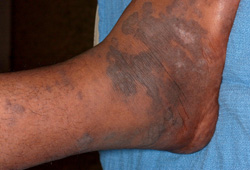Case history
Case history #1
A 35-year-old homosexual man with HIV infection presents with recent painless purple skin plaques on his lower legs and generalised lymphadenopathy. He has similar skin lesions on his trunk and a purple-coloured mass on his hard palate. [Figure caption and citation for the preceding image starts]: Kaposi's sarcoma cutaneous purple-brown plaque on the footFrom the collection of Dr Bruce J. Dezube; used with permission [Citation ends].
Case history #2
A 68-year-old man of Mediterranean descent presents with a slow-growing purple mass on his foot with focal ulceration that is accompanied by lymphoedema. He is HIV-negative.
Other presentations
Patients may present with visible vascular mucocutaneous lesions or may be asymptomatic. HIV-associated KS has a variable clinical course, ranging from minimal disease from an incidental finding, to explosive growth resulting in significant morbidity and mortality. Intra-oral lesions may present due to pain, bleeding, ulceration, and because patients complain of problems related to mastication, speech, and swallowing. If the conjunctiva is involved it may result in redness of the eye, discharge, and possibly obscured vision. Patients frequently present with visceral disease, especially when they have AIDS. If the gastrointestinal (GI) tract is involved, individuals can present with weight loss, abdominal pain, nausea and vomiting, ileus, upper or lower GI tract bleeding, malabsorption, intestinal obstruction, and, infrequently, diarrhoea. If the lower respiratory tract is involved, patients may experience shortness of breath, fever, cough, haemoptysis, and chest pain, and may develop a serosanguinous pleural effusion. Although unlikely, KS could involve mass-forming lesions on any location on the body and/or cause organ compromise. Rarely, KS lesions may occur within surgical wounds or chronically inflamed skin lesions. Finally, individuals may present solely because of the psychosocial stress from the stigma associated with having these lesions, or as a result of cosmetic concerns.
Use of this content is subject to our disclaimer